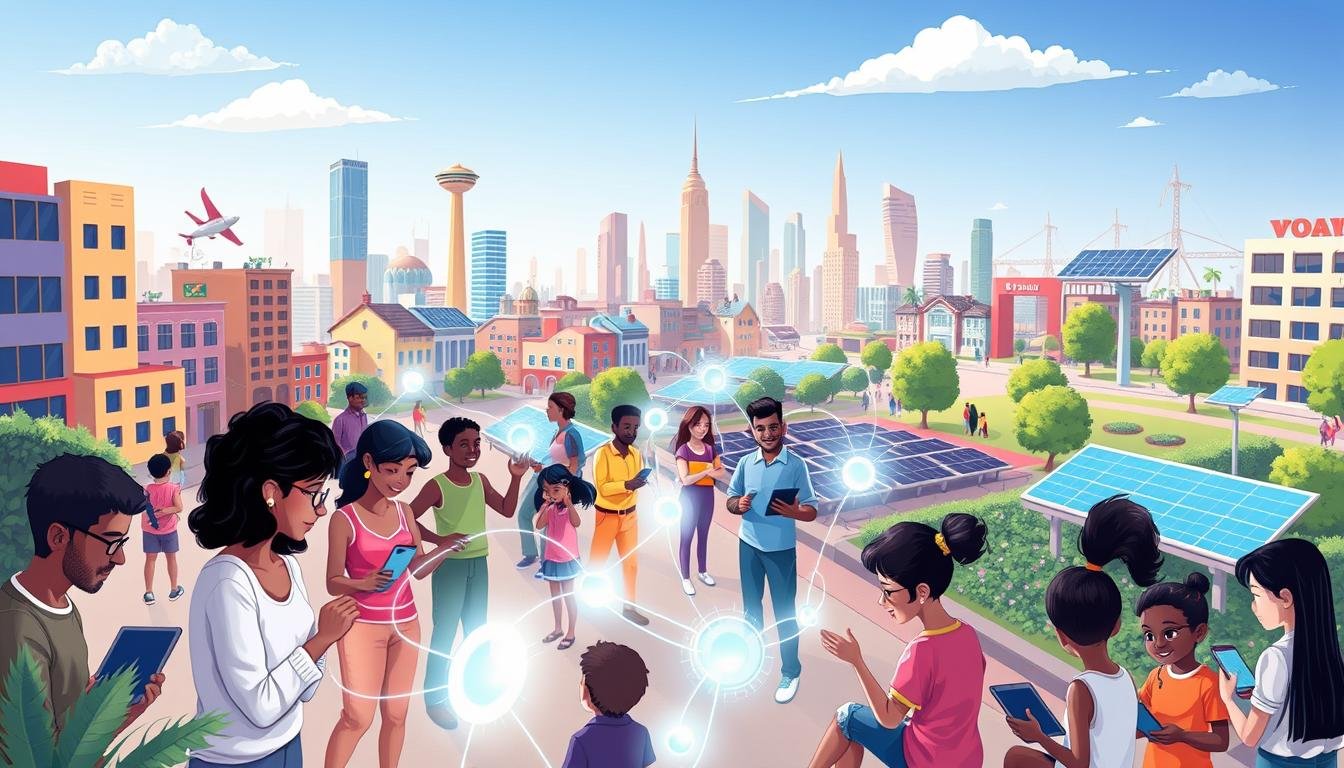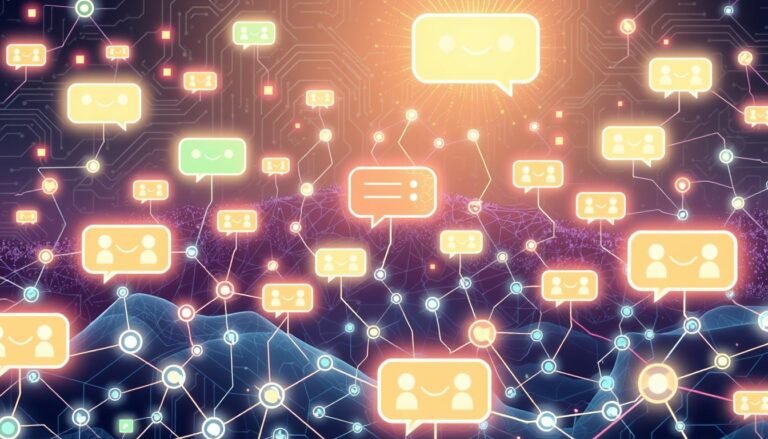Addressing the Digital Divide: Solutions for 2025
Why, in an era where technology advances at lightning speed, are billions still offline?
The digital divide is a big problem for a global digital future. By 2022, nearly 2.7 billion people, or one-third of the world’s population, still don’t have internet access. This shows we need new solutions and teamwork to make sure everyone can join the digital world.
We need affordable internet and digital literacy programs to solve these issues. Working towards digital equity and closing the digital gap is key. Our efforts over the next few years will show if we can make a world where everyone, no matter where they are or who they are, can use the internet. This article explores the steps we can take to make this dream a reality by 2025.
Key Takeaways
- Billions of people remain offline, highlighting a global digital divide.
- Access, affordability, and utilization gaps impact internet connectivity.
- Urban areas have double the penetration rates of rural areas.
- Middle and high school students without home internet are academically disadvantaged.
- Innovative global initiatives aim to bridge this divide by 2025.
Understanding the Digital Divide
The digital divide is a big problem in today’s world. It’s about unequal access to technology. The United Nations-Habitat says we need to understand it well to make technology more accessible to everyone.
Defining the Digital Divide
The digital divide is when some people can’t use technology like others. This can be because they don’t have internet or don’t know how to use it. The UN-Habitat says we must fix this to make the world more fair.
Global Statistics and Trends
There are big differences in who can use the internet. Only 70% of the world has internet, leaving 2.7 billion without. In Africa, 12 countries have very low digital skills. In the U.S., 87% of homes have devices for internet, but only 73% actually have internet.
This problem is even bigger in schools:
| Demographic | Students Lacking Internet or Only Dial-Up (%) |
|---|---|
| American Indian | 27% |
| Black | 19% |
| Hispanic | 17% |
| Pacific Islander | 12% |
| Two or more races | 7% |
| White | 7% |
| Asian | 3% |
Socio-Economic Factors Contributing to the Digital Divide
Many things make the digital divide worse, especially for those who are not as well off. Things like age, how much money you make, and where you live affect if you can use technology.
- Only 57% of people making less than $30,000 have internet at home. But 95% of those making $100,000 or more do.
- 25% of households getting help with internet are Black and 25% are Latino. This shows efforts to help.
- 82% of Historically Black Colleges and Universities (HBCUs) are in areas without good internet. This shows big problems in education.
- 1 in 3 U.S. workers don’t have basic digital skills. This makes it hard for them to get jobs in the future.
These facts show we really need to keep working on making technology accessible to everyone. Working together and getting help from companies like Viasat is key to solving this problem.
Investing in Broadband Infrastructure
The push for strong rural broadband is key to closing the digital gap by 2025. Technology is now crucial for economic growth. Rural areas need better access fast.
Rural Broadband Initiatives
Investing in rural broadband can boost local economies. The US government has spent over $100 billion to bridge the digital gap. A 10% increase in broadband could have created 875,000 jobs and added $186 billion to the economy by 2019.
Yet, 65% of U.S. counties don’t meet internet speed standards. This number jumps to 77% in rural areas. India’s success in expanding rural internet shows what’s possible.
Government and Private Sector Collaborations
Working together is key to better rural broadband. In 2018, a Microsoft study found 19 million rural Americans lack broadband. Government and private sectors must team up to fix this.
Successful partnerships have been seen in Kenya and Rwanda. Their fiber optic investments boosted internet speeds and the economy. South Korea and Singapore’s 5G efforts also show the way forward.
| Region | Investment Example | Impact |
|---|---|---|
| United States | $100 billion in infrastructure investments | Potential 875,000 jobs and $186 billion economic output |
| India | Government-led rural broadband initiatives | Increased internet penetration in rural areas |
| Kenya and Rwanda | Investments in fiber optic networks | Improved internet speeds and economic growth |
Government efforts are crucial, but private sector help speeds up affordable internet. Together, they can boost innovation, education, and healthcare. This leads to more jobs and lasting economic growth.
Affordable Internet Access: Key to Digital Inclusion
Having affordable internet is key to digital inclusion. It lets people from all walks of life join online activities and get important services. By focusing on affordable internet access, we can make the digital world more inclusive.
Subsidies and Investment Programs
Many subsidies and programs help with digital inclusion plans. For example, AT&T plans to spend $5 billion by 2030. They aim to give 25 million people fast, affordable internet. These efforts are crucial for not leaving behind those who are less connected.
Digital navigators are important in teaching people about the internet. They help users understand and use online tools well. Also, programs that offer good technical support are key. They help users feel confident and keep them engaged online.
Case Studies: Successful Affordable Internet Programs
Looking at successful cases shows how focused efforts can make a big difference. By the end of 2023, nearly 840,000 people got digital help from AT&T Connected Learning®. Over 180,000 students and teachers also used The AchieverySM, a free learning platform.
The impact of broadband equity programs is huge. In 2023, more than 162,000 people got technology and computers. This shows how these programs can really help make the internet more inclusive.
| Program | Impact | Year |
|---|---|---|
| AT&T Connected Learning® | 840,000 individuals received digital resources | 2023 |
| The AchieverySM | 180,000 students and educators reached | 2023 |
| Broadband Equity Initiatives | 162,000 people received technology and computers | 2023 |
| Ready, Tech, Go! Workshops | Workshops in 35 underserved elementary schools | 2023 |
These examples show how important well-planned and funded digital inclusion plans are. They make sure everyone can access affordable internet.
Supporting Digital Literacy and Skills Training
As technology skills become more important, it’s key to focus on digital literacy and training. About 3.7 billion people worldwide lack reliable internet, making education and jobs hard to get. To help, many programs are starting to teach tech skills and improve community connectivity.
Educational Initiatives
Almost 80% of employers see digital literacy as a must-have skill. Schools and groups are now focusing on tech training. For example, remote learning can boost retention by up to 25%.
- Partnerships between schools and tech companies give students access to new digital tools.
- Adding coding, data analysis, and cybersecurity to school curricula.
- MOOCs offer free digital literacy courses to many.
But, 20% of people face barriers because they lack access to basic services like education. So, we need special programs for these communities.
Community Programs and Workshops
Community efforts are key to improving digital literacy and community connectivity. Groups like The Arc of the United States are leading with new programs:
| Initiative | Details |
|---|---|
| The Arc and AT&T Collaboration | A partnership between The Arc of the United States, The Arc San Francisco, and AT&T, with an $850,000 investment to boost digital literacy for people with IDD. |
| Grants for Digital Literacy Training | $20,000 grants to 24 local chapters and $10,000 grants to 2 local chapters of The Arc. This aims to train 6,250 individuals with IDD in digital literacy. |
| Public Awareness Campaign | Efforts to reach over 3 million people with disabilities through advocacy and heightened public awareness. |
These efforts are crucial because 38% of adults with disabilities don’t own a computer, compared to 19% without disabilities. Also, 28% of people with disabilities don’t have a smartphone, versus 12% without disabilities.
By investing in these areas, we can close the digital gap and build stronger, more connected communities.
The Role of Technology Equity in Bridging the Divide
Technology equity is key to closing the digital gap in our world. It ensures everyone has access to technology and digital tools. This supports digital human rights and promotes inclusion by fixing access and skill gaps. During the COVID-19 pandemic, students from low-income families struggled with internet issues.
In 2020, $2.2 billion was spent on education tech in the U.S. But, 33% of low-income students still face internet problems. This shows how vital technology equity is for digital human rights. Investing in better internet in low-income areas can help bridge the digital gap.
Equitable tech policies, like the Affordable Connectivity Program, help low-income families get internet. Programs like Greenlining’s Town Link offer digital skills and affordable internet. This helps address the digital resource gap that can widen educational gaps.
The Community College of Aurora spent nearly $2 million on tech upgrades. This shows the need for financial support for technology equity. It also helps fight algorithmic bias, which unfairly affects some communities.
Policymakers must focus on funding and reforms to ensure fair tech use. This includes making algorithms transparent and fair. Updating civil rights laws to tackle algorithmic bias is also crucial. It helps ensure everyone gets a fair chance with technology.
Addressing the Digital Divide: Solutions for the Future
To tackle the digital divide, we need new ideas and teamwork between governments and groups. In 2022, 62% of men and 57% of women worldwide used the internet. Closing this gap is key.
Building more broadband is essential. From 2015 to 2021, 4G coverage grew to 88%. By 2028, it could hit 95%. But, rural areas have half the internet access of cities. So, we must focus on getting internet to rural areas.
Creating sustainable digital strategies is also vital. The U.S. is spending $65 billion to make digital access fairer. This effort targets students of color and those in rural and urban areas. Investing in digital skills training can help more people use the internet.
Also, making internet affordable is crucial. By December 2021, only 25% of eligible households got the FCC’s Emergency Broadband Benefit. Raising awareness and training can help more people get internet.
Working together is important to reach these goals. Partnerships can make digital plans work with bigger goals for development. Setting up teams in schools and making programs easy to join are good steps. Also, training families and students can help a lot.
| Year | Statistics |
|---|---|
| 2022 | 62% of global males, 57% of global females using the internet |
| 2015-2021 | 4G network coverage doubled to 88% |
| 2022 | 80% of Europeans, 22% of Africans with internet access |
| 2028 | Projected 95% global 4G coverage |
| 2014 | Estimated $186 billion economic output and 875,000 U.S. jobs with a 10% broadband access increase |
| 2021 | Less than 25% of eligible households enrolled in FCC’s Emergency Broadband Benefit |
Fixing the digital divide needs smart plans and teamwork. By improving infrastructure, making internet affordable, and working together, we can make the internet available to all.
Community Connectivity: Local Solutions
Creating a digitally inclusive society needs local efforts. We must tailor strategies to meet community needs. This drives more people to use digital tools and makes them accessible.
Engaging Local Stakeholders
Getting local groups involved is key to solving digital issues. This includes governments, businesses, schools, and citizens. Together, they ensure the community’s needs are met and resources are used well. This boosts digital inclusion, letting more people join the digital world.
Developing Community-Based Digital Inclusion Plans
Creating plans for digital inclusion starts with knowing what a community needs. This might include:
- Digital literacy programs: Classes and workshops to teach basic digital skills.
- Affordable internet access: Working with ISPs to offer cheap broadband.
- Technology access points: Free internet zones in libraries and community centers.
- Partnerships: Local businesses and groups providing devices and tech support.
Here’s why fast internet is crucial for different groups:
| Speed Category | Examples | Requirements |
|---|---|---|
| Unserved | Below 25/3 Mbps | Households with little internet use |
| Underserved | 25/3 Mbps – 100/20 Mbps | Small families, basic streaming, and online learning |
| Served | Above 100/20 Mbps | Large families, businesses, online classes, and remote work |
By focusing on local digital solutions, communities can reduce the digital divide. This ensures everyone has fair access to digital tools. It boosts the economy, education, and overall life quality.
Conclusion
The journey to bridge the digital divide is complex but vital. Internet and computer access vary greatly across states. For example, Washington and Colorado have high rates, while Mississippi and Arkansas have much lower rates. This shows we need specific plans to help communities and make the digital world more inclusive.
Racial disparities add another challenge. From 2017 to 2021, progress was made in internet access for different racial groups. Yet, rates like 7% for non-Hispanic Asians and 18% for Hispanic households show we must keep working. We need to improve digital infrastructure, make internet more affordable, and teach people about technology.
Looking at countries like Japan, Taiwan, and South Korea, we see hope. They’ve invested heavily in digital infrastructure and seen great success. Their stories teach us that with the right strategies and teamwork, we can create a fair digital world. By learning from them and staying committed, we can make a big difference by 2025. This will improve lives, economic chances, and social bonds worldwide.
Source Links
- Addressing the Digital Divide | UN-Habitat
- Reducing the Digital Divide for Families: State and Local Policy Opportunities
- Fixing the global digital divide and digital access gap
- Understanding the Digital Divide in Education | AU
- Why is addressing the digital divide important?
- Solutions to Bridging the Digital Divide | Robert F. Smith
- Bridging the Digital Divide with Broadband
- Report: With Digital Divide Widening, Accessible Broadband Access is a Top Equity Issue Facing America’s Counties
- Bridging the Digital Divide: The Role of Infrastructure in Enhancing Connectivity
- Embrace the Future with Digital Inclusion
- AT&T – Corporate Responsibility – Digital Divide
- Skills Training for Underserved Communities
- Empowering Through Technology: Major Initiative to Boost Digital Skills for Disabled Communities – The Arc
- Understanding the Digital Equity Gap and Bridging the Digital Divide in Higher Ed
- Technology Equity – The Greenlining Institute
- Bridging the Gap: Addressing the Digital Divide’s Impact on Education
- The Digital Divide: What It Is, and What’s Being Done to Close It
- Path to Digital Equity: Why We Need to Address the Digital Divide with Solutions Around Adoption – Digital Promise
- Bridging the Digital Divide: Community Broadband Solutions for All | Grantworks
- Council Post: Addressing The Digital Divide In Education: Technology And Internet Access For Students In Underserved Communities
- How Rural Connectivity Solutions are Shaping the Future | Conexon
- The Digital Divide | What It Is and How It Impacts Us
- Benefits of Closing the Global Digital Divide – Connecting the Unconnected








